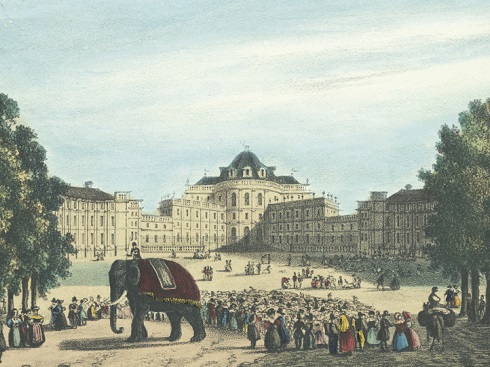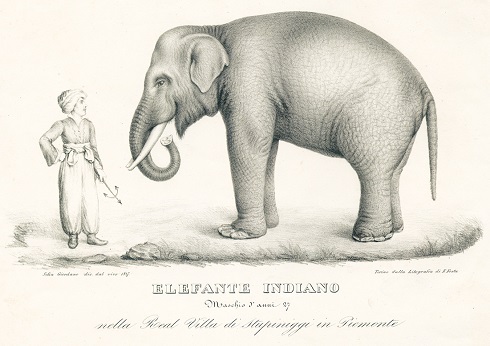PROJECT GRAN GALA CEIRANO / FRITZ LUCKY CHARM
Castello di Stupinigi, litografia di Demetrio Festa su disegno di Enrico Gonin, 1835 (Collezione Simeom, D 830)
Elefante indiano maschio di anni 27 nella Real Villa di Stupiniggi in Piemonte, litografia Felice Festa su disegno dal vivo di Sofia Giordano, 1827 (Collezione Simeom, D 1870)
ITALIANO. Il Fritz Portafortuna è l'elefante ricoperto in vero argento riservato in premio al vincitore del Gran Gala Ceirano.
L'elefante Fritz fu nel XIX secolo un protagonista amato della vita di Stupinigi.
Le tradizioni buddista e indù riconoscono nell'elefante un simbolo di pazienza e saggezza, mentre quella cristiana lo considera emblema di castità e temperanza: gli vengono universalmente riconosciute doti di forza, intelligenza e memoria eccezionali e le sue riproduzioni sono considerate portafortuna, purché la proboscide sia rivolta verso l'alto e venga rivolta verso una finestra della casa in cui viene posizionato.
Se il Toro è l'animale simbolo della Città di Torino e del marchio Ruzza Torino ed il Cervo è l'animale simbolo della Palazzina di Caccia di Stupinigi, l'elefante Fritz può essere considerato il simbolo dell'attrazione stessa delle manifestazioni di Torino e Stupinigi e la sua fine tragica può essere per tutti stimolo per una profonda riflessione sul valore di chi offre il proprio talento al prossimo.
ENGLISH. The
Fritz Lucky Charm is the elephant covered in real silver reserved as
a prize for the winner of the Grand Gala Ceirano.
The
elephant Fritz was a beloved protagonist of Stupinigi's life in the
XIX century.
The
Buddhist and Hindu traditions recognize in the elephant a symbol of
patience and wisdom, while the Christian one considers it an emblem
of chastity and temperance: they are universally recognized as having
exceptional qualities of strength, intelligence and memory and its
reproductions are considered good lucky charms, provided that the
proboscis is facing up and facing a window of the house where it is
placed.
If
Taurus is the symbolic animal of the City of Turin and of the Ruzza
Torino brand and the Deer is the symbolic animal of the Hunting
Lodge of Stupinigi, the elephant Fritz can be considered the symbol
of the attraction itself of the Turin and Stupinigi events and his
tragic end can be a stimulus for everyone for a profound reflection
on the value of those who offer their talent to others.
PROJECT GRAN GALA CEIRANO / FRITZ STORY
ITALIANO. Nella prima metà del 1800 il Regno di Sardegna sviluppò un
programma per rafforzare i rapporti con gli esteri e fu così che Re
Carlo Felice di Savoia fece inviare 100 pecore merinos al Vicerè
d'Egitto Mohamed Alì, che ricambiò inviando in Piemonte un elefante
indiano di 27 anni, di nome Fritz: Fritz all'epoca era il nome
universalmente dato agli elefanti in cattività, addomesticati per i
circhi o per i parchi privati.
Fritz venne imbarcato ad
Alessandria d'Egitto il 24 Ottobre 1826 e raggiunse Genova, dove
passò l'inverno: con l'arrivo della primavera del 1827 venne messo
in marcia verso Torino, a piedi, accompagnato da due guardie
egiziane.
L'arrivo del pachiderma venne assistito da Andrea
Bonelli, direttore del Museo Zoologico dell'Università di Torino (In
seguito Museo di Scienze Naturali), che preparò le indicazioni per
la sua gestione, successivamente vigilata dai colleghi Giuseppe Genè
e Filippo De Filippi: doveva essere lavato una volta al mese e unto
con 4 libbre di burro ed ogni giorno doveva disporre per la sua
alimentazione di 50 pani, 24 cavoli, riso, burro e tabacco e vere 2
pinte di vino mentre le castagne vennero riservate come premio
speciale (Di cui fece poi indigestione). Era già serrato il legame
fra il Museo delle Zoologico e la Palazzina di Caccia di Stupinigi,
considerando che già alla fine del 1700 era stato costruito un
serraglio nel podere San Carlo per ospitare animali esotici: per
Fritz venne creato uno spazio interamente recintato, la Ménagerie
gestita da Casimiro Roddi, e nel cortile fu posta una piscina con
scivolo, affinché si rinfrescasse.
Tutti lo amarono sin da
subito, anche perché sin da subito venne utilizzato per intrattenere
i visitatori con spettacoli e passeggiate nel parco, intervallate da
momenti musicali in cui Fritz mostrava doti da ballerino.
Appena
giunto a Stupinigi fu ritratto dal vivo dalla pittrice Sofia Giordano
mentre nel 1835 Enrico Gonin lo dipinse attorniato da una folla
durante una passeggiata in fronte alla Palazzina: nel 1829 perse un
dente da cui il regio ebanista Giacomo Marchino realizzò un
Crocifisso (Tutt'oggi conservato sull'altare della Cappella del
Castello di Aglié) e nel Marzo del 1832 un secondo dente, che venne
donato a Re Carlo Alberto.
Lo scenario cambiò però quando morì
il guardiano di Fritz, che divenne immediatamente triste e iniziò a
rifiutare di esibirsi mentre la salita al trono di Vittorio Emanuele
II fu anche accompagnata da una serie di tagli alle spese ritenute
inutili: in questo contesto, un episodio del 1852 divenne decisivo
per la vita di Fritz. Il nuovo guardiano colpì l'elefante alla
proboscide con un tridente, ferendolo: alcuni indicano la cosa come
accidentale, altri come voluta in seguito ai rifiuti di esibirsi del
pachiderma. Fritz avvolse il guardiano con la proboscide e lo lanciò
in alto: quando caddé al suolo morì sul colpo, restando fermo a
terra definitivamente, mentre Fritz andò a raccogliere il tridente e
lo pose al suo fianco.
Si diffusero voci eccessive, indicandolo
come impazzito: Re Vittorio Emanuele II ne ordinò la condanna a
morte, eseguita l'8 Novembre 1852. Si decise per sopprimerlo in modo
indolore, utilizzando l'ossido di carbonio prodotto da una stufa
appositamente realizzata e per la consegna dei suoi resti al Museo di
Scienze Naturali, dove è stato custodito dopo essere stato
tassidermizzato.
E' curioso notare che il primo dente perso da Fritz è custodito nel Castello di Aglié, dove venne trovato morto Emanuele Cacherano di Bricherasio, il filantropo che sostenne i Ceirano e fondò la FIAT.
ENGLISH. In
the first half of the 1800s the Kingdom of Sardinia developed a
program to strengthen relations with foreigners and it was thus that
King Carlo Felice of Savoy had 100 merino sheep sent to the Viceroy
of Egypt Mohamed Ali, who returned by sending an Indian elephant from
27 years old, named Fritz: Fritz at the time was the name universally
given to captive elephants, domesticated for circuses or for private
parks.
Fritz
was embarked in Alexandria of Egypt on October 24, 1826 and reached
Genoa, where he spent the winter: with the arrival of the spring of
1827 he was put on foot towards Turin, accompanied by two
Egyptian guards.
The
arrival of the pachyderm was assisted by Andrea Bonelli, director of
the Zoological Museum of the University of Turin (later the Museum of
Natural Sciences), who prepared the indications for his management,
subsequently supervised by the colleagues Giuseppe Genè and Filippo
De Filippi: he had to to be washed once a month and greased with 4
pounds of butter and they had to prepare daily for its food 50
breads, 24 cabbages, rice, butter and tobacco and 2 pints of wine
while the chestnuts were reserved as a special prize (of which he
then did indigestion). The link between the Zoological Museum and the
Hunting Palace of Stupinigi was already tightened, considering that
already at the end of the 1700s a seraglio was built on the San Carlo
estate to house exotic animals: a completely fenced-in space was
created for Fritz, the Ménagerie managed from Casimiro Roddi, and a
swimming pool with a slide was placed in the courtyard, to refresh
him.
Everyone
loved him right away, also because he was immediately used to
entertain visitors with shows and walks in the park, interspersed
with musical moments in which Fritz showed his dancing skills.
As
soon as he arrived in Stupinigi he was portrayed live by the painter
Sofia Giordano while in 1835 Enrico Gonin painted him surrounded by a
crowd during a walk in front of the Hunting Palace: in 1829 he lost a
tooth from which the royal cabinet-maker Giacomo Marchino made a
Crucifix (still today preserved on the altar of the Chapel of the
Castle of Aglié) and in March 1832 a second tooth, which was donated
to King Carlo Alberto.
However,
the scenario changed when the guardian of Fritz died, who immediately
became sad and began to refuse to perform while Vittorio Emanuele
II's ascent to the throne was also accompanied by a series of cuts to
the expenses deemed unnecessary: in this context, an episode of the
1852 became decisive for Fritz's life. The new guardian struck the
elephant to the trunk with a trident, wounding him: some indicate it
as accidental, others as intended following the refusal of the
pachyderm to exhibit. Fritz wrapped the guardian with his trunk and
threw him high: when he fell to the ground he died instantly,
remaining firm on the ground definitively, while Fritz went to
collect the trident and placed it beside him.
Excessive
rumors spread, pointing to him as crazy: King Vittorio Emanuele II
ordered his death sentence, executed on November 8th 1852. It was
decided to suppress him painlessly, using the carbon monoxide
produced by a specially made stove and for the delivery of his
remains to the Natural Science Museum, where he was kept after being
taxidermed.
It
is curious to note that the first tooth lost by Fritz is kept in the
Castle of Aglié, where Emanuele Cacherano of Bricherasio, the
philanthropist who supported the Ceiranos and founded FIAT, was found
dead.


